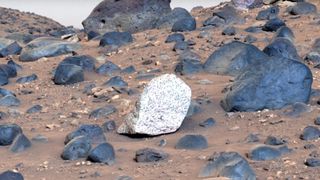SPACE
LIVE SCIENCE
published June 19, 2024
NASA's Perseverance rover spotted a bizarrely light-toned boulder on Mars, the likes of which have never been seen before.

NASA's Perseverance rover spotted a bizarrely light-toned boulder on Mars, the likes of which have never been seen before.

An image taken by NASA's Perseverance on May 27 while surveying Mount Washburn caught sight of the pale boulder "Atoko Point". (Image credit: NASA/JPL-Caltech/ASU/MSSS)
NASA's Perseverance rover has spotted an unusually light-colored rock in Mars' Jezero Crater — the likes of which has never been seen on the Red Planet before. According to project researchers, the strange boulder may hint at new details about Mars' ancient past.
The rock, dubbed "Atoko Point" after a similarly light-colored feature of the Grand Canyon, is "in a league of its own," clearly standing out amidst all the darker boulders dotting the search area near the crater's Mount Washburn, the team wrote in a NASA statement. Scientists caught their first glimpse of the rock as part of an 18-image mosaic taken on May 27.
Atoko Point is estimated to measure 18 inches (45 centimeters) wide and 14 inches (35 centimeters) tall. Using the rover's camera instruments, SuperCam and Mastcam-Z, the scientists confirmed that the rock was made of pyroxene and feldspar. The team speculated that the pale rock may have been transported from a different part of the planet via an ancient river, or formed underground by a body of magma before ultimately being revealed through erosion.
"The diversity of textures and compositions at Mount Washburn was an exciting discovery for the team, as these rocks represent a grab bag of geologic gifts brought down from the crater rim and potentially beyond," Brad Garczynski of Western Washington University in Bellingham and co-lead of the current science campaign said in the statement.
The researchers added that while Atoko is "first of its kind" spotted on Mars, it almost certainly "won't be the last" as Perseverance continues its mission toward the rim of Jezero Crater.
Related: NASA's Perseverance rover may already have found signs of life on Mars, discovery of ancient lake sediments reveals
Perseverance landed on Mars in February 2021, and has been exploring Jezero Crater — a region thought to have once been an ancient lake — ever since. The rover's primary mission is to find signs of ancient life, and it has already collected 24 geological samples for future study.
Get the world’s most fascinating discoveries delivered straight to your inbox.Contact me with news and offers from other Future brandsReceive email from us on behalf of our trusted partners or sponsorsBy submitting your information you agree to the Terms & Conditions and Privacy Policy and are aged 16 or over.

A map of Perseverance's mission route along the Neretva Vallis river channel, the path to Bright Angel. (Image credit: NASA/JPL-Caltech/University of Arizona)
The current trip through Jezero Crater is part of Perseverance's fourth science campaign to find carbonate and olivine minerals along the crater's rim. On Earth, carbonates are usually found on the shallow surfaces of freshwater lakes, forming when carbon dioxide reacts with water. By analyzing these minerals, scientists may catch a glimpse of the Mars' past carbon dioxide levels, an important indicator of its historical climate. Carbonates are also excellent minerals for preserving fossils, which may point to traces of ancient life, if they existed.
Recently, Perseverance has been doing a little detour from Mount Washburn to reach "Bright Angel", an area within the Neretva Vallis channel, an ancient river that once flowed to Jezero Crater. The team will decide whether to collect a rock core sample as they survey the new territory.
Kristel Tjandra
Staff Writer
Kristel is a science writer based in the U.S. with a doctorate in chemistry from the University of New South Wales, Australia. She holds a master's degree in science communication from the University of California, Santa Cruz. Her work has appeared in Drug Discovery News, Science, Eos and Mongabay, among other outlets. She received the 2022 Eric and Wendy Schmidt Awards for Excellence in Science Communications.
NASA's Perseverance rover has spotted an unusually light-colored rock in Mars' Jezero Crater — the likes of which has never been seen on the Red Planet before. According to project researchers, the strange boulder may hint at new details about Mars' ancient past.
The rock, dubbed "Atoko Point" after a similarly light-colored feature of the Grand Canyon, is "in a league of its own," clearly standing out amidst all the darker boulders dotting the search area near the crater's Mount Washburn, the team wrote in a NASA statement. Scientists caught their first glimpse of the rock as part of an 18-image mosaic taken on May 27.
Atoko Point is estimated to measure 18 inches (45 centimeters) wide and 14 inches (35 centimeters) tall. Using the rover's camera instruments, SuperCam and Mastcam-Z, the scientists confirmed that the rock was made of pyroxene and feldspar. The team speculated that the pale rock may have been transported from a different part of the planet via an ancient river, or formed underground by a body of magma before ultimately being revealed through erosion.
"The diversity of textures and compositions at Mount Washburn was an exciting discovery for the team, as these rocks represent a grab bag of geologic gifts brought down from the crater rim and potentially beyond," Brad Garczynski of Western Washington University in Bellingham and co-lead of the current science campaign said in the statement.
The researchers added that while Atoko is "first of its kind" spotted on Mars, it almost certainly "won't be the last" as Perseverance continues its mission toward the rim of Jezero Crater.
Related: NASA's Perseverance rover may already have found signs of life on Mars, discovery of ancient lake sediments reveals
Perseverance landed on Mars in February 2021, and has been exploring Jezero Crater — a region thought to have once been an ancient lake — ever since. The rover's primary mission is to find signs of ancient life, and it has already collected 24 geological samples for future study.
Get the world’s most fascinating discoveries delivered straight to your inbox.Contact me with news and offers from other Future brandsReceive email from us on behalf of our trusted partners or sponsorsBy submitting your information you agree to the Terms & Conditions and Privacy Policy and are aged 16 or over.

A map of Perseverance's mission route along the Neretva Vallis river channel, the path to Bright Angel. (Image credit: NASA/JPL-Caltech/University of Arizona)
The current trip through Jezero Crater is part of Perseverance's fourth science campaign to find carbonate and olivine minerals along the crater's rim. On Earth, carbonates are usually found on the shallow surfaces of freshwater lakes, forming when carbon dioxide reacts with water. By analyzing these minerals, scientists may catch a glimpse of the Mars' past carbon dioxide levels, an important indicator of its historical climate. Carbonates are also excellent minerals for preserving fossils, which may point to traces of ancient life, if they existed.
Recently, Perseverance has been doing a little detour from Mount Washburn to reach "Bright Angel", an area within the Neretva Vallis channel, an ancient river that once flowed to Jezero Crater. The team will decide whether to collect a rock core sample as they survey the new territory.
Kristel Tjandra
Staff Writer
Kristel is a science writer based in the U.S. with a doctorate in chemistry from the University of New South Wales, Australia. She holds a master's degree in science communication from the University of California, Santa Cruz. Her work has appeared in Drug Discovery News, Science, Eos and Mongabay, among other outlets. She received the 2022 Eric and Wendy Schmidt Awards for Excellence in Science Communications.
No comments:
Post a Comment